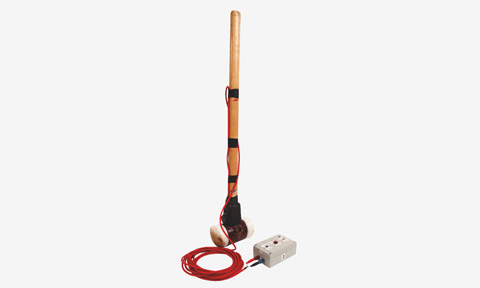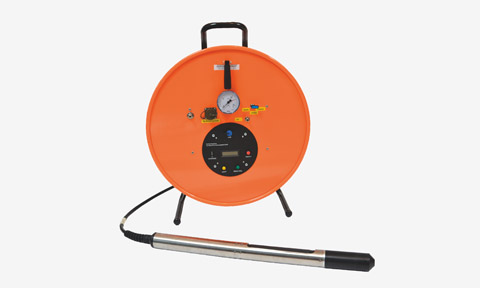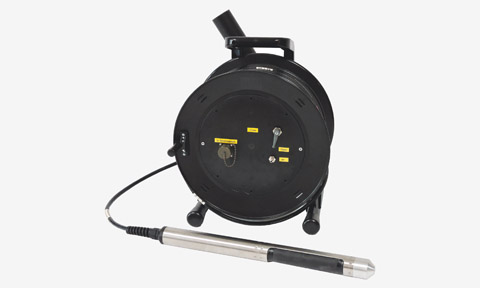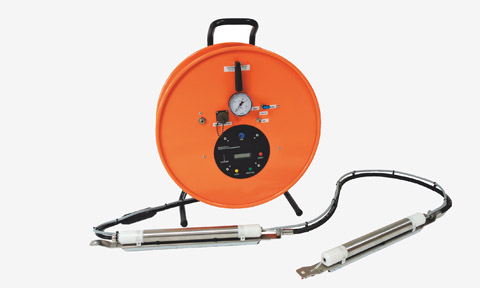The downhole test provides shear wave velocities (VS) and compressional wave velocities (VP) for geological layers along a single borehole. Soil dynamic parameters, such as shear modulus, Poisson ratio and Young’s modulus can be determined to evaluate the soil’s response to dynamic loading. The downhole test has a lower vertical resolution than the crosshole test.
Depths up to 100 m
In general, the standard downhole test is applied for near surface investigations using a simple sledge hammer as surface source together with different kinds of analog borehole geophones designed for maximum depths of around 100 m.
Source
Sledge Hammer | Surface Source
The sledge hammer is used to generate seismic waves (P- or S-waves) at the surface. A piezotrigger element is attached to the hammer. The output piezo signal is transformed to a TTL pulse by a small box to provide an exact time break to the seismograph.
It is a suitable source for shallow downhole surveys up to a depth of 100 m.

Receivers
BGK3/7 | Borehole Geophone
The borehole geophone BGK3 is used to receive P- and S-waves in dry or water filled boreholes. The borehole geophone BGK3 consists of a tri-axial sensor whereas the BGK7 consists of six horizontal sensors, separated by 30° intervals, and one vertical sensor. The geophone is coupled to the borehole wall by a pneumatic clamping system (inflatable bladder). Air is supplied to the BGK3/7 through an electro-pneumatic hybrid cable with a Kevlar tension string. A magnetic compass shows azimuthal deviation to North and can be used to get the orientation of the geophone in the borehole. The cable is terminated by a connector to the seismograph.

Download product sheet.pdf
BGK5 | Borehole Geophone
The borehole geophone BGK5 is used to receive P- and S-waves in dry or water filled boreholes. The borehole geophone BGK5 consists of four horizontal sensors, separated by 45° intervals, and one vertical sensor. The geophone is coupled to the borehole wall by a pneumatic clamping system (inflatable bladder). Air is supplied to the BGK5 through an electro-pneumatic hybrid cable with a Kevlar tension string. The cable is terminated by a connector to the seismograph.

Download product sheet.pdf
DDS | Dual Downhole System
The Dual Downhole System (DDS) is used to receive P- and S-waves in dry and water filled boreholes in order to determine interval velocities. The DDS consists of two stations each equipped with tri-axial sensors. The stations are mechanically connected to each other to ensure the alignment of all horizontal sensors. Both stations are coupled to the borehole wall by a pneumatic clamping system (inflatable bladder). Air is supplied to the DDS through an electro-pneumatic hybrid cable with a Kevlar tension string. A magnetic compass shows azimuthal deviation to North and can be used to get the orientation of the DDS in the borehole. The cable is terminated by a connector to the seismograph.

Download product sheet.pdf
-----------------------------------------------------------------------------------------------------------------------
Depths up to 2000 m
In case of deeper underground investigations (e.g. for nuclear end storage investigations or mining purposes) large weighted vibrator surface sources are required together with a digital borehole geophone whose technology fulfills the requirements for downhole measurements in depths up to 2000 m.
Receiver
BGK1000 | Borehole Geophone
The BGK1000 is a digital borehole geophone used to receive P- and S-waves in dry and water filled boreholes. It is manufactured by Hinz Messtechnik GmbH and exclusively distributed by Geotomographie. The borehole geophone BGK1000 consists of a downhole probe with a tri-axial geophone sensor and a surface communication unit connected to the USB port of a laptop. Optionally, a hydrophone sensor can be added. An auxiliary channel can be connected to the surface unit to record an external seismic signal, i.e. a pilot vibrator sweep. Triggering is made via the surface unit allowing TTL pulse, geophone or contact triggering. The borehole geophone is designed to run on a winch equipped with a 4-conductor cable and a Gearhart Owen cable head. The geophone is coupled to the borehole wall by a mechanical clamping system (motor-driven arm). A magnetic compass is used to get the sensor orientation in the borehole. Seismic data are stored in SEG2 format by the acquisition software. A seismograph is not required.



